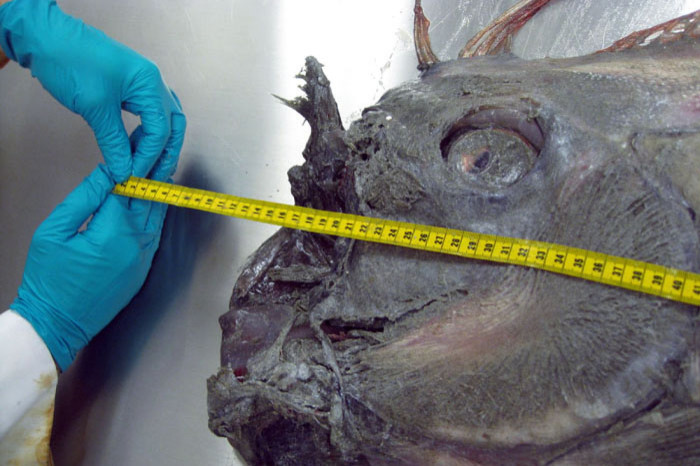Giant Oarfish Dissected In California, Find Out What Was Inside Mysterious Sea Serpent [PHOTOS]

When a mysterious deep-sea creature washes ashore, aside from taking “thumbs up” photos with it, the next best thing to do is open it up and see what’s going on inside. Over the past few weeks, researchers from the National Oceanic and Atmospheric Administration’s center in La Jolla, Calif., and scientists from the University of California, Santa Barbara dissected two giant oarfish that washed up on California’s beaches earlier this month.
“It’s a pretty cool animal,” one marine biologist told ABC 10 in San Diego. “It’s a once in a lifetime opportunity to see a fish like this.”
Researchers discovered that one of the oarfish, the 14-footer that appeared in Oceanside on Oct. 18, was about to have babies. The other, an 18-footer found by a snorkeler near Catalina Island, was riddled with parasitic worms.
"Our findings say that these are actually majorly parasitized fish," Armand Kuris, a professor of zoology at UCSB, said in a statement. "In this little piece of intestine that we had, we found quite a few of these rather large larval tapeworms. One of them was about 15 centimeters (6 inches) long."
Kuris and his team found a few dozen of the tapeworms in a small segment of the oarfish, in addition to two juvenile roundworms. They also pulled out an adult spiny-headed worm that had rooted itself in the fish’s intestine. "These [findings] tell you about what the natural enemies of the oarfish are," Kuris noted.
In La Jolla, scientists opened up the 14-foot oarfish found near Oceanside and discovered that it was about to be a mother. Researchers mined hundreds of thousands of eggs from inside the fish’s 6-foot-long ovaries that were ready to be released.
The researchers also found that the fish had lost its tail to hungry cookiecutter sharks, small predators named for their tendency to leave tiny, round gouges in their prey.
Oarfish carry the title of the world’s longest bony fish, a group that includes almost all fish except sharks and rays. The mysterious deep sea-dwelling fish can grow more than 30 feet long – with some reaching nearly 50 feet in length – and may be the inspiration of seas monsters remored throughout history.
Oarfish are rarely seen by humans, mainly because they stick to deep waters and never take bait. Videos or photos of the rare creatures occasionally crop up on the Internet, but scientists hardly ever get to study one of them up close.
"With careful chemical analysis of the lipids and the proteins, we should be able to tell what its diet is and where it fits in the food chain," Russ Vetter, a NOAA biologist said in a podcast from the agency. He added that DNA samples will help scientists understand how the oarfish evolved and how the fish is related to other species.
© Copyright IBTimes 2025. All rights reserved.






















